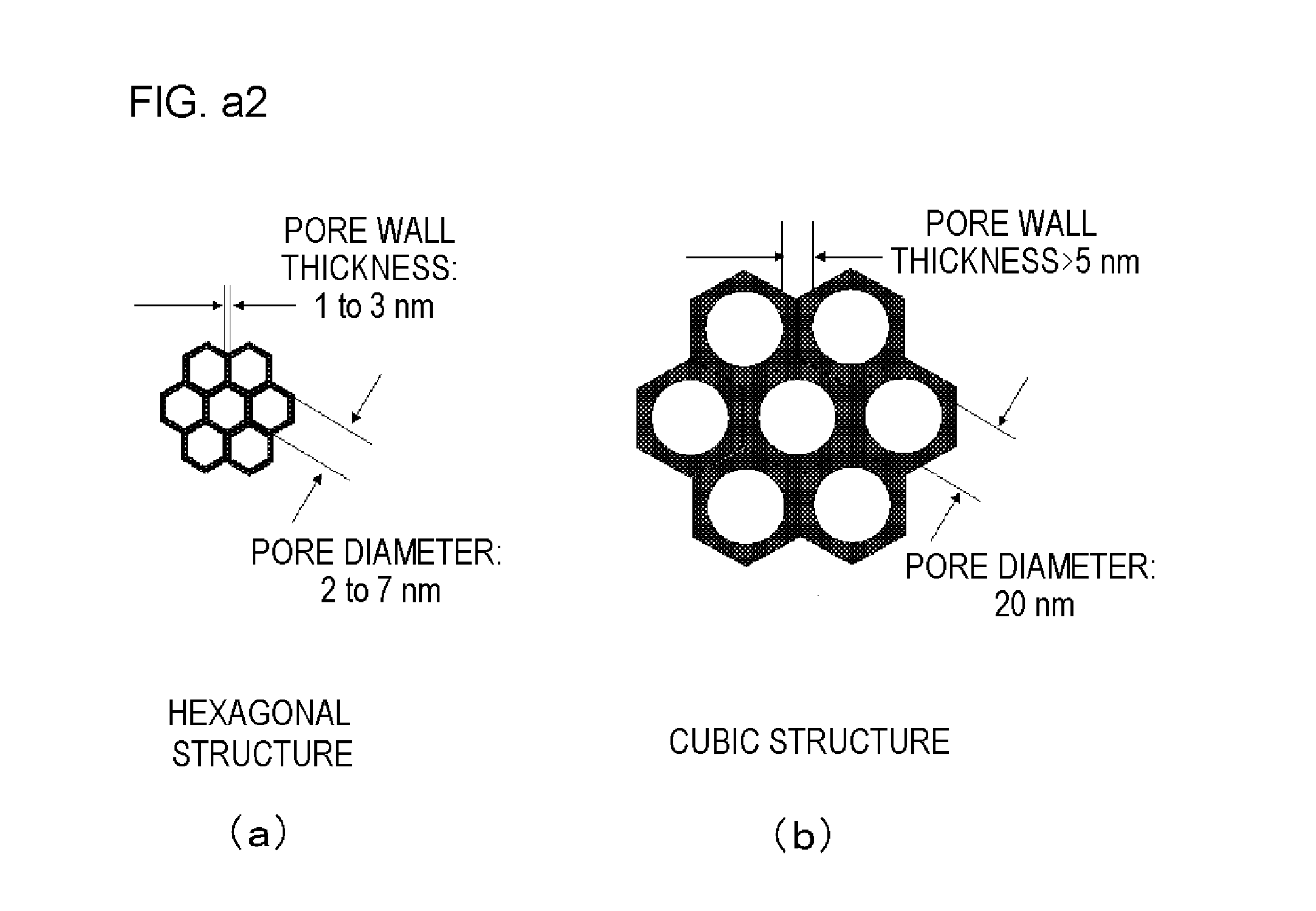Novel porous metal oxide, method for producing the same, and use of the same
- Summary
- Abstract
- Description
- Claims
- Application Information
AI Technical Summary
Benefits of technology
Problems solved by technology
Method used
Image
Examples
first embodiment
1. First Embodiment
[0147]The porous metal oxide of the present invention has uniform mesopores, and its average pore diameter is from 5 to 30 nm and preferably from 10 to 30 nm.
[0148]In general, examples of the uniform three-dimensional regular structure include a lamellar structure, a hexagonal structure and a cubic structure as shown in schematic views of FIG. a1, FIG. a2 and FIG. a3. The lamellar structure is a structure obtained by alternatively stacking a planar inorganic layer and a plate-like air layer, in which pores become a plate-like layer. The hexagonal structure is a honeycomb-formed structure of a hollow column (ideally a hexagonal prism) structure, and a porous structure with uniform pores in which uniform pores are aligned in an orderly manner in a high density. There are several forms in the cubic structure. Typical examples include Pm3n, Im3n, Fm3m, Fd3m, and further Ia3d, Pn3m and Im3n in which mesopores are bicontinuously bonded, as shown in the schematic view of...
second embodiment
2. Second Embodiment
[0410]The insulating film of this embodiment comprises the porous metal oxide of the first embodiment. A film comprising the porous metal oxide in which mesopores forms a cubic phase and the average pore diameter is from 5 to 30 nm achieves high mechanical strength because its pore wall thickness is thick at the same porosity as compared to a hexagonal structure having an average pore diameter of not more than 5 nm (FIG. a2).
[0411]In mesoporous silica synthesized by the method described in Non-Patent Documents 1 and 2, the dielectric constant of about 2 to 2.5 can be obtained. However, in the related art described in Non-Patent Documents 1 and 2, as a method of lowering the dielectric constant to 2 or less, a method of increasing the porosity by increasing the concentration of the surfactant is considered. However, there is a problem such that the intended porosity can not be obtained due to a disintegration of a micellar aggregate structure. And there is a probl...
third embodiment
3. Third Embodiment
[0443]The filler of this embodiment comprises the metal oxide particles formed from the porous metal oxide of the first embodiment which has uniform mesopores and has an average pore diameter of 5 to 30 nm.
[0444]In Patent Document 3, in case of hollow silica particles, a thickness of the pore wall is thin, the structure is easily disintegrated. Accordingly, the porosity of hollow silica particle can not be increased, and the porosity of the coating film formed by mixing it with a resin matrix is further lowered, so that satisfactory low dielectric constant is not achieved.
[0445]On the other hand, according to this embodiment, with the use of the terminally branched copolymer particles in which the average particle size of 50% by volume is small and the particle size is constant regardless of the dilute concentration, there is provided a filler in which cubic phase pores are formed, the average pore diameter is large, and low dielectric constant is achieved.
[0446]H...
PUM
 Login to View More
Login to View More Abstract
Description
Claims
Application Information
 Login to View More
Login to View More - R&D
- Intellectual Property
- Life Sciences
- Materials
- Tech Scout
- Unparalleled Data Quality
- Higher Quality Content
- 60% Fewer Hallucinations
Browse by: Latest US Patents, China's latest patents, Technical Efficacy Thesaurus, Application Domain, Technology Topic, Popular Technical Reports.
© 2025 PatSnap. All rights reserved.Legal|Privacy policy|Modern Slavery Act Transparency Statement|Sitemap|About US| Contact US: help@patsnap.com



